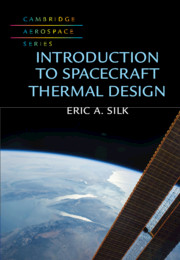Book contents
- Introduction to Spacecraft Thermal Design
- Cambridge Aerospace Series
- Introduction to Spacecraft Thermal Design
- Copyright page
- Dedication
- Contents
- Figures
- Tables
- Nomenclature
- Subscripts
- 1 Introduction
- 2 Conduction Heat Transfer Analysis
- 3 Radiative Heat Transfer Analysis
- 4 The Space Environment
- 5 Space-Based Advanced Thermal Conductance and Storage Technologies
- 6 Sensors, Instrumentation and Test Support Hardware
- 7 Fundamentals of Cryogenics
- 8 Developmental and Environmental Testing
- Book part
- Index
- Solutions
- References
4 - The Space Environment
Published online by Cambridge University Press: 19 June 2020
- Introduction to Spacecraft Thermal Design
- Cambridge Aerospace Series
- Introduction to Spacecraft Thermal Design
- Copyright page
- Dedication
- Contents
- Figures
- Tables
- Nomenclature
- Subscripts
- 1 Introduction
- 2 Conduction Heat Transfer Analysis
- 3 Radiative Heat Transfer Analysis
- 4 The Space Environment
- 5 Space-Based Advanced Thermal Conductance and Storage Technologies
- 6 Sensors, Instrumentation and Test Support Hardware
- 7 Fundamentals of Cryogenics
- 8 Developmental and Environmental Testing
- Book part
- Index
- Solutions
- References
Summary
Spacecraft, which we will also refer to as satellites in this text, comprise one or multiple instruments and subsystems that enable measurements and/or observations, platform orientation, health monitoring and uplink/downlink communications. Generally, instruments are comprised of subsystems and subsystems are comprised of components. Thermal control system (TCS) design considerations are applied to all items onboard a spacecraft, and the most stringent requirements typically apply to items associated with instruments. This is because instruments typically carry specially designed hardware built to perform a specific type of measurement (or observation) in space. Adherence of spaceflight system operations to properly defined thermal parameters (i.e., requirements) enables the success of the thermal control system applied.
- Type
- Chapter
- Information
- Introduction to Spacecraft Thermal Design , pp. 114 - 164Publisher: Cambridge University PressPrint publication year: 2020



